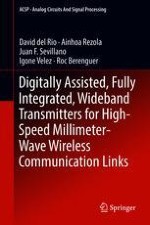This book presents design methods and considerations for digitally-assisted wideband millimeter-wave transmitters. It addresses comprehensively both RF design and digital implementation simultaneously, in order to design energy- and cost-efficient high-performance transmitters for mm-wave high-speed communications. It covers the complete design flow, from link budget assessment to the transistor-level design of different RF front-end blocks, such as mixers and power amplifiers, presenting different alternatives and discussing the existing trade-offs. The authors also analyze the effect of the imperfections of these blocks in the overall performance, while describing techniques to correct and compensate for them digitally. Well-known techniques are revisited, and some new ones are described, giving examples of their applications and proving them in real integrated circuits.
